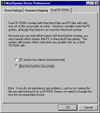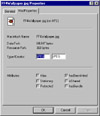|
|
||
Click on a thumbnail to enlarge it. Use your browser's "BACK" button to return to this review when done. |
||
| Many of today's programs have versions that run on both the PC and the Macintosh, such as Adobe PageMaker, Adobe Photoshop, Microsoft Word, and Microsoft Excel. These cross platform programs have increased the need to move files back and forth between the Macintosh and PC. MacOpener 4.0, created by DataViz, allows Windows users to read, write and format Mac media on the PC, including Zip, Jaz, SyQuest, HD floppies and other removable media. MacOpener's extension mapping technology allows users to double click Mac files and and open them in the same application on the PC. Price: $59.95. Upgrade Price: $29.95. MacOpener works with files that are cross platform compatible. DataViz has developed another program Conversion Plus that is useful when you are dealing with incompatible file formats across platforms or programs, e-mail file attachments or compressed files. The DataViz Web site is: http://www.dataviz.com | ||
| Beginning, Intermediate, and Advanced PC users. The program is user friendly and could be used by anyone with basic computer knowledge. | ||
|
||
|
Installation, User's Guide, & Help. The program is very easy to install, and it took almost no time at all. There is a small but thorough User's Guide that provides all of the information you need. There is also excellent Online Help. Interface. I had read the information
on what the program could do before I installed it, s Copying Files to and from Macintosh Disks.
With MacOpener, you can access Macintosh disks from the Windows Desktop,
Explorer or any program's "Open" or "Save As" me Fo Driver Preferences. When you install MacOpener, you install the MacOpener driver that gives you access to Macintosh disks from anywhere on your PC. This driver includes a number of preferences for using Macintosh disks and copying files. The Preferences can be accessed through the Start menu of Windows or the MacOpener Program Group. There are three tabs.
Macintosh Properties. When you are viewing Macintosh disks and files with MacOpener, you are able to view the properties of the file or folder just as you would with PC files and folders. When you right click on the Macintosh file/folder and select Properties, you will get a tab entitled MacProperties. This will give you Macintosh specific information. |
||
| This program is great for desktop publishers, graphic artists, or anyone who uses both a Mac and a PC. You don't have to worry about finding the appropriate PC formatted disk to use with the Mac, and you don't have to worry about file names. It is also useful to have access to all those volumes of clip art and stock images that were previously unavailable to Windows applications. | ||
| Operating System: Windows 3.1, 95, 98 & NT 4.0 Hard Disk Space: 2MB Memory: 4MB RAM |
||
|
Scanner: Hewlett Packard ScanJet 6250C Professional Series |
||







